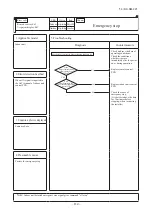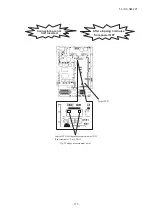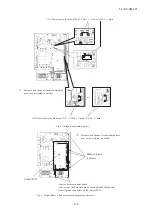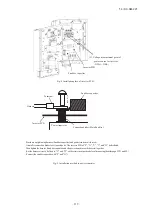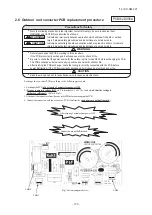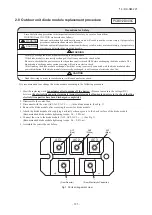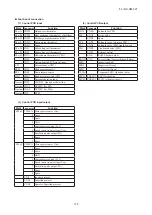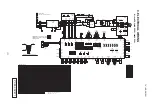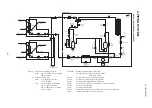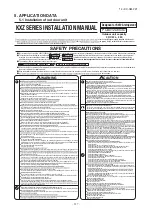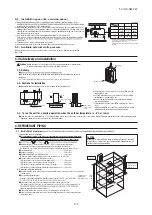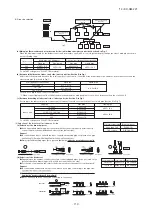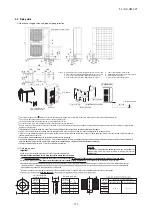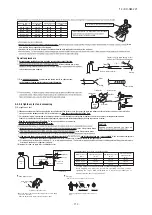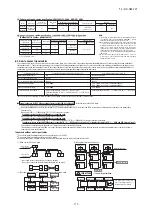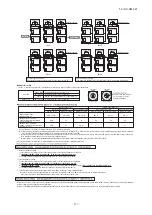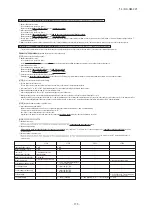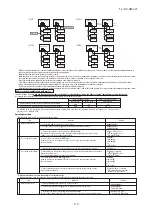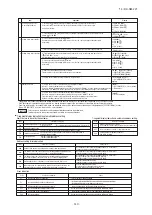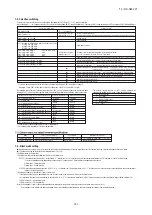
–
127
–
'14 • KX-SM-221
Out door unit
Height difference
between indoor
units: 18 m
Height difference
30 m
Actual length
120 m
Total piping length 150 m
Indoor unit
Suction
Blowout
195
195
690
Foundation bolt position
(4 places)
20
520
20
●
The protrusion of an anchor bolt on the front side must be
kept within 15 mm.
●
Securely install the unit so that it does not fall over during
earthquakes or strong winds, etc.
●
Refer to the above illustrations for information regarding
concrete foundations.
●
Install the unit in a level area. (With a gradient of 5 mm or
less.)
Improper installation can result in a compressor failure, broken
piping within the unit and abnormal noise generation.
Wooden base
Wear plate
Fig
1
Indoor unit
Indoor unit
Outdoor unit
Branch pipe set for indoor unit side
Model: DIS
Branch pipe set for indoor unit side
Model: DIS
Header set for indoor unit side
Model: HEAD
A
B
B
C
C
B
B
C
C
C
C
C
C
2.Install the outlet air blow side of the unit in a
position perpendicular to the direction of wind.
Wind direction
Wind direction
Fasten with anchor bolts
Over 500 mm
(2) If the unit can be affected by strong wind, following measures are required. Strong wind can cause damage of fan (fan motor), or can cause performance degradation, or can
trigger anomalous stop of the unit due to rising of high pressure.
1.Install the outlet air blow side of the unit to face a
wall of building, or provide a fence or a windbreak
screen.
3.The unit should be installed on the stable and level
foundation. If the foundation is not level, tie down
the unit with wires.
Since drain water generated by defrost control may freeze, following measures are required.
●
Don’t execute drain piping work by using a drain elbow and drain grommets (optional parts). [Refer to Drain piping work.]
●
Recommend setting Defrost start temperature and Outdoor fan snow protection control. [Refer to 7-2. change of control]
Accessory
Caution
●
Be sure to read this manual before installation to follow the proper installation methods.
●
When installing the indoor unit, read the installation manual of indoor unit.
●
Optional distribution parts are required for the piping (Branch pipe set, header set). For details, refer to the catalog, etc.
●
Make sure to install the earth leakage breaker. (Select a product compatible with high frequency.)
●
There is risk of damaging the compressor if the unit is operated while the discharge pipe thermistor, suction pipe thermistor, pressure sensor, etc. are removed. Never attempt to
operation in such condition.
●
With this air-conditioning system, room temperature may rise, depending on installation conditions, while indoor units are stop
the stopped indoor units if heating operation is conducted on the system.
Combination pattern
●
Combination pattern of outdoor units, number of indoor units connected and capacity of connection are as show in the table.
●
It can be used in combination with the following indoor unit.
Name
Quantity
1
1
1
Location of use
It is attached to the bracket with an adhesive tape
in the proximity of the service valve.
Attached on the base below the operation valve.
Placed in front of the compressor
Capacity
224
280
Combination pattern
Single
Single
Number of units connected (unit)
1
〜
8
1
〜
8
Range of total capacity of connected indoor units
112
〜
268
140
〜
336
1. BEFORE BEGINNING INSTALLATION
3-1. Delivery
2. INSTALLATION LOCATION
(Obtain approval from the customer when selecting the installation area.)
2-1. Selecting the installation location
●
●
To hoist the unit, attach a pair of textile ropes with cushion materials attached to protect it.
Request
Put cushion materials between the unit and the ropes to avoid damages.
Attach the ropes on the unit and carry it in avoiding displacement of gravity center.
Improper slinging may cause the unit to lose balance and fall.
4. REFRIGERANT PIPING
3. Unit delivery and installation
(1) Limitation on use of pipes
(3) Pipe size selection
Caution
●
When arranging pipes, observe the limitation on use concerning the maximum piping length, total piping length,
allowable pipe length from initial branching and allowable difference of height (difference between heads).
●
●
Maximum length (To the furthest indoor unit) … 120 m or less as actual pipe length.
It is required to change the pipe diameter when the actual length exceeds 90 m.
Determine the size of main pipe, referring to the table of main pipe selection table of (3) (a).
●
Total piping length …………………………………………………………150 m or less
●
Length of main pipe ……………………………………………………… 90 m or less
●
Allowable pipe length from initial branching …………………………… 40 m or less
Difference in pipe lengths between indoor units, however, is 40 m or less.
●
Allowable difference in height (Difference of heads)
(a) When an indoor unit is positioned at a higher place ……………… 30 m or less
(b) When an outdoor unit is positioned at a lower place ……………… 30 m or less
(c) Difference of heights between indoor units in a system …………… 18 m or less
(d) Difference of heights between initial branching and indoor unit … 18 m or less
(2) Selection of pipe material
●
Use pipes with the inside clean and free from any harmful sulfur, oxides, dirt, chips & oil, or moisture
(contamination).
●
Use following refrigerant pipes.
Material … Phosphate deoxidation treated seamless pipe (C1220T-O, 1/2H, JIS H3300)
C1220T-1/2H for O.D. ø19.05 or more, or C1220T-O for ø15.88 or less
●
Wall thickness and size - Select according to the guide for pipe size selection
(This product uses R410A. Since, in case of pipes in the size of ø19.05 or more, materials of -O
thickness larger than the minimum thickness.)
●
When a pipe is branched, make sure to use our branching set or header set.
●
When setting branching pipes, take care of the mounting direction and consult carefully with the
instruction manual.
●
When installing the unit, make sure to lock its legs with the following bolts.
3-2. Cautions for installation
CAUTION
Make sure to install within the range of limitation. Otherwise, resulting
malfunction of compressor may not be warranted. Observe always the
limitation of use during installation.
Edging
ID 22.22
Accessory
pipe (280 only)
Instruction manual
Use it for protection of a knock-out hole.
Use this when connecting gas pipe.
When the installation work is completed,
give instructions to the customer and ask him/her to keep it.
4-1
. Restrictim on use of pipes
(
)
Lock with bolt (M10-12)
Suction
Blowout
Use a long block to extend the width.
Use a thicker
block to anchor
deeper.
PCB012D053D
KXZ SERIES INSTALLATION MANUAL
◎
espective installation manuals supplied with the units.
Outdoor unit capacity
FDC224, 280
Notabilia as a unit designed for R410A
a
)
b
)
c
)
d
)
e
)
f
)
g
)
h
)
Gauge manifold
Charge hose
Electronic scale for refrigerant charging
Torque wrench
Flare tool
Protrusion control copper pipe gauge
Vacuum pump adapter
Gas leak detector
Dedicated R410A tools
●
Do not use any refrigerant other than R410A. R410A will rise to pressure about 1.6 times higher than that of a conventional refrigerant.
●
A unit designed for R410A has adopted a different size outdoor unit service valve charge port and a different size check joint provided in the unit to
measurement have also been altered to raise strength against pressure. Accordingly, you are required to arrange dedicated R410A tools listed in the
table on the right before installing or servicing this unit.
●
Do not use a charge cylinder. The use of a charge cylinder will cause the refrigerant composition to change, which results in performance degradation.
●
In charging refrigerant, always take it out from a cylinder in the liquid phase.
●
All indoor units must be models designed exclusively for R410A. Check connectable indoor unit models in a catalog, etc.
(A wrong indoor unit, if connected into the system, will impair proper system operation)
Sample
Size
L
1
L
2
L
3
L
4
Ⅰ
Open
300
150
250 (5)
Ⅱ
Open
5
300
250 (5)
Ⅲ
500
Open
150
250 (5)
Air
inlet
Air
inlet
Air
outlet
Service
space
L
3
L
2
L
4
L
1
(Unit : mm)
consult with your distributor or the manufacturer)
b) When installing units side by side, it is necessary to secure the service space of minimum 250 mm
between them. The units can be operated, however, if they are separated by more than 5 mm each
other. Where this minimum space is not available, it may be adapted by moving one of the units, for
example, during the service work.
c) Don’t install at a place where it will be surrounded with walls in four directions.
Even when it is not surrounded with walls in four directions and it is met the installation conditions
short-circuit.
d) There must be a 1-meter or larger space in the above.
e) A barrier wall placed in front of the exhaust diffuser must not be higher than the unit.
2-2. Installation space (Ex. servicing space)
When attaching a duct to inlet or outlet of outdoor unit, it can be use by follwing static pressure.
Max: 35Pa
2-3. Available external static pressure
Floor surface
Floor surface
Floor surface
Liquid side
Horizontal
Floor surface
Floor surface
Gas side
Floor surface
Branching at
downstream
side
[Items sold separately]
Refrigerant pipe distribution parts, which are not contained in the package, will be required for installation.
As for refrigerant pipe distribution parts, we offer branching pipe sets (Model type: DIS) and header sets (Model type: HEAD) as parts used on the indoor side of piping.
Select according to the application. In selecting distribution parts, refer to “4. REFRIGERANT PIPING.”
If you are not sure which parts to select, consult with your dealer.
Use refrigerant branching pipe sets and header sets designed exclusively for R410A without fail.
CAUTION
Otherwise, a risk of compressor and/or electric component
failure may arise.
Outdoor unit
224
280
Gas pipe
ø19.05×t1.0
ø22.22×t1.0
Liquid pipe
ø9.52×t0.8
Gas pipe
ø22.22×t1.0
ø28.58, ø25.4×t1.0
Liquid pipe
ø9.52×t0.80
Main pipe size (Ordinary)
Pipe size for actual length longer than 90 m
For ø19.05 or larger, use C1220T-1/2H material.
For ø19.05 or larger, use C1220T-1/2H material.
*1: When connecting indoor units of 280 at the downstream and the main gas pipe is of ø22.22 or larger, use the pipe of ø22.22x t1
(a) Main pipe (Between branch at outdoor unit side - initial branch at indoor unit side): Section A in Fig. 1
When the maximum length (to the furthest indoor unit from outdoor unit) is 90 m or more (actual length), change the size of main pipe as shown
by the following table.
(b) Between initial branch at indoor unit side- indoor unit side: Section B in Fig. 1
Select from following table based on the total capacity of indoor units connected at the downstream side. However, it should never exceed the
size of main pipe (Section A in Fig. 1).
Total capacity of indoor units
Less than 70
70 - 180
180 or more
Gas pipe
ø12.7 ×t1.0
ø15.88×t1.0
ø19.05×t1.0 *
1
Liquid pipe
ø 9.52×t0.8
For ø19.05 or larger, use C1220T-1/2H material.
Total capacity downstream
Less than 180
180 or more
Branch pipe set
DIS-22-1G
DIS-180-1G
(c) Between branching at indoor unit side - indoor unit side: Section C in Fig. 1
According to the table of pipe size for indoor unit. However, it should never exceed the size of main pipe (Section A in Fig. 1).
(4) Selection of the branch set for indoor unit side
(a) Selection of the branch pipe set
●
As an appropriate branching pipe size varies with the connected capacity (total capacity
connected downstream), determine a size from the table at right.
Request
●
In connecting an indoor unit with the indoor unit side branching pipe set, please use a pipe
●
Always install branching pipes (both gas and liquid pipe)
either horizontally or vertically.
(b) Selection of the header set
●
Depending on the number of units connected, connect plugged pipes (to be procured on the
installer’s part) at a branching point (on the indoor unit connection side).
●
For the size of a plugged pipe, refer to the documentation for a header set (optional part).
Request
●
In connecting a header with an indoor unit, please use a pipe conforming to the pipe size
●
In installing a header, always arrange a gas-side header to branch horizontally and a
liquid-side header to branch downward.
●
Indoor units 224 and 280 can not be connected to the header.
Capacity
15
,
22
,
28
36
,
45
,
56
71
,
90
,
112
,
140
,
160
224
280
Gas pipe
ø 9.52×t0.8
ø 12.7×t0.8
ø15.88×t1.0
ø19.05×t1.0
ø22.22×t1.0
Liquid pipe
ø6.35×t0.8
ø9.52×t0.8
Indoor unit
Vertical
Floor surface
Floor surface
Floor surface
Floor surface
Horizontal
Total capacity downstream
Less than 180
180 or more
Header set model
HEAD4-22-1G
HEAD6-180-1G
Number of branches
Max. 4 branches
Max. 6 branches
SAFETY PRECAUTIONS
●
We recommend you to read this "SAFETY PRECAUTIONS" carefully before the installation work in order to gain full advantage of the functions of the unit and to avoid malfunction due to mishandling.
●
The precautions described below are divided into and . The matters with possibilities leading to serious consequences such as death or serious personal
injury due to erroneous handling are listed in the and the matters with possibilities leading to personal injury or damage of the unit due to erroneous handling including
probability leading to serious consequences in some cases are listed in .
These are very important precautions for safety. Be sure to observe all of them without fail.
●
The meaning of"Marks"used here are as shown on the right.
●
s well as the maintenance methods of this equipment to
the user according to the owner's manual.
●
Keep the installation manual together with owner's manual at a place where any user can read at any time. Moreover if necessary, ask to hand them to a new user
●
n before usage.
Never do it under any circumstance.
Always do it according to the instruction.
WARNINGS
WARNINGS
CAUTIONS
CAUTIONS
●
injury , as a result of a system malfunction.
●
Install the system in full accordance with the instruction manual.
●
refrigerant leak, substandard performance, control failure and personal injury.
●
When installing in small rooms, take prevention measures not to exceed the density limit of refrigerant in the event of
leakage accordance with ISO5149.
Consult the expert about prevention measures. If the density of refrigerant exceeds the limit in the event of leakage, lack
of oxygen can occur, which can cause serious accidents.
●
Ventilate the working area well in the event of refrigerant leakage during installation.
●
After completed installation, check that no refrigerant leaks from the system.
If refrigerant leaks into the room and comes into contact with an oven or other hot surface, poisonous gas is produced.
●
out of alignment, be sure to hang up the unit at 4-point support.
An improper manner of portage such as 3-point support can cause death or serious personal injury due to falling of the unit.
●
Install the unit in a location with good support.
Unsuitable installation locations can cause the unit to fall and cause material damage and personal injury.
●
Ensure the unit is stable when installed, so that it can withstand earthquakes and strong winds.
Unsuitable installation locations can cause the unit to fall and cause material damage and personal injury.
●
and "national wiring regulation", and the system must be connected to the dedicated circuit.
●
Be sure to shut off the power before starting electrical work.
Failure to shut off the power can cause electric shocks, unit failure or incorrect function of equipment.
●
Be sure to use the cables conformed to safety standard and cable ampacity for power distribution work.
●
Use the prescribed cables for electrical connection, tighten the cables securely in terminal block and relieve the cables
correctly to prevent overloading the terminal blocks.
●
Arrange the wiring in the control box so that it cannot be pushed up further into the box. Install the service panel correctly.
●
In connecting the power cable, make sure that no anomalies such as dust deposits, socket clogging or wobble are found
and insert the plug securely.
●
Be sure not to reuse existing refrigerant pipes
Conventional refrigerant oil or chlorine contained in the conventional refrigerant which is remaining in the existing
refrigerant pipes can cause deterioration of refrigerant oil of new unit. And 1.6 times higher pressure of R410A refrigerant
than conventional one can cause burst of existing pipe, personal injury or serious accident.
●
Do not perform brazing work in the airtight room
It can cause lack of oxygen.
●
Using existing parts (for R22 or R407C) can cause the unit failure and serious accidents due to burst of the refrigerant circuit.
●
nut too much.
which may result in lack of oxygen.
●
Do not open the service valves for liquid line and gas line until completed refrigerant piping work, air tightness test and evacuation.
If the compressor is operated in state of opening service valves before completed connection of refrigerant piping work, you
cause burst or personal injury due to anomalously high pressure in the refrigerant.
●
Do not put the drainage pipe directly into drainage channels where poisonous gases such as sulphide gas can occur.
●
●
Do not perform any change of protective device itself or its setup condition
The forced operation by short-circuiting protective device of pressure switch and temperature controller or the use of non
●
Be sure to switch off the power source in the event of installation, inspection or servicing.
If the power source is not shut off, there is a risk of electric shocks, unit failure or personal injury due to the unexpected start of fan.
●
Consult the dealer or an expert regarding removal of the unit.
●
Stop the compressor before closing valve and disconnecting refrigerant pipes in case of pump down operation.
If disconnecting refrigerant pipes in state of opening service valves before compressor stopping, you may incur frost bite
anomalously high pressure in the refrigerant circuit.
●
Ensure that no air enters in the refrigerant circuit when the unit is installed and removed.
If air enters in the refrigerant circuit, the pressure in the refrigerant circuit becomes too high, which can cause burst and personal injury.
●
Do not run the unit with removed panels or protections
Touching rotating equipments, hot surfaces or high voltage parts can cause personal injury due to entrapment, burn or electric shocks.
●
●
●
Use the circuit breaker for all pole with correct capacity.
●
Take care when carrying the unit by hand.
If the unit weights more than 20kg, it must be carried by two or more persons. Do not carry by the plastic straps, always
●
Dispose of any packing materials correctly.
Any remaining packing materials can cause personal injury as it contains nails and wood. And to avoid
danger of suffocation, be sure to keep the plastic wrapper away from children and to dispose after tear it up.
●
Pay attention not to damage the drain pan by weld spatter when welding work is done near the indoor unit.
If weld spatter entered into the indoor unit during welding work, it can cause pin-hole in drain pan and
result in water leakage. To prevent such damage, keep the indoor unit in its packing or cover it.
●
Be sure to insulate the refrigerant pipes so as not to condense the ambient air moisture on them.
furniture and any other valuables.
●
Be sure to perform air tightness test by pressurizing with nitrogen gas after completed refrigerant piping work.
If the density of refrigerant exceeds the limit in the event of refrigerant leakage in the small room, lack
of oxygen can occur, which can cause serious accidents.
●
Perform installation work properly according to this installation manual.
Improper installation can cause abnormal vibrations or increased noise generation.
●
Carry out the electrical work for ground lead with care.
Do not connect the ground lead to the gas line, water line, lightning conductor or telephone line's
ground lead. Incorrect grounding can cause unit faults such as electric shocks due to short-circuiting.
Never connect the grounding wire to a gas pipe because if gas leaks, it could cause explosion or ignition.
●
Earth leakage breaker must be installed
●
Do not use any materials other than a fuse with the correct rating in the location where fuses are to be used.
●
Do not install the unit near the location where leakage of combustible gases can occur.
●
Do not install the unit where corrosive gas (such as sulfurous acid gas etc.) or combustible gas (such as
thinner and petroleum gases) can accumulate or collect, or where volatile combustible substances are handled.
●
●
When the outdoor unit is installed on a roof or a high place, provide permanent ladders and handrails
along the access route and fences and handrails around the outdoor unit.
If safety facilities are not provided, it can cause personal injury due to falling from the installation place.
●
Equipment such as inverters, standby generators, medical high frequency equipments and telecommunication
equipments can affect the system, and cause malfunctions and breakdowns. The system can also affect
medical equipment and telecommunication equipment, and obstruct its function or cause jamming.
●
Do not install the outdoor unit in a location where insects and small animals can inhabit.
n.
●
Do not use the base frame for outdoor unit which is corroded or damaged due to long periods of operation.
Using an old and damage base frame can cause the unit falling down and cause personal injury.
●
Do not install the unit in the locations listed below
t
t
Locations where any substances that can affect the unit such as sulphide gas, chloride gas, acid and alkaline can occur.
t
Vehicles and ships
t
Locations where cosmetic or special sprays are often used.
t
Locations with direct exposure of oil mist and steam such as kitchen and machine plant.
t
Locations where any machines which generate high frequency harmonics are used.
t
Locations with salty atmospheres such as coastlines
t
Locations with heavy snow (If installed, be sure to provide base frame and snow hood mentioned in the manual)
t
Locations where the unit is exposed to chimney smoke
t
Locations at high altitude (more than 1000m high)
t
Locations with ammonic atmospheres
t
Locations with calcium chloride (e.g. snow melting agent).
t
Locations where heat radiation from other heat source can affect the unit
t
Locations without good air circulation.
t
Locations with any obstacles which can prevent inlet and outlet air of the unit
t
Locations where short circuit of air can occur (in case of multiple units installation)
t
Locations where strong air blows against the air outlet of outdoor unit
●
Do not install the outdoor unit in the locations listed below.
t
Locations where discharged hot air or operating sound of the outdoor unit can bother neighborhood.
t
Locations where outlet air of the outdoor unit blows directly to an animal or plants. The outlet air can
affect adversely to the plant etc.
t
t
Locations where vibration and operation sound generated by the outdoor unit can affect seriously.
(on the wall or at the place near bed room)
t
Locations where an equipment affected by high harmonics is placed. (TV set or radio receiver is placed within 5m)
t
Locations where drainage cannot run off safely.
It can affect surrounding environment and cause a claim
●
Do not use the unit for special purposes such as storing foods, cooling precision instruments and
preservation of animals, plants or art.
It can cause the damage of the items.
●
Do not touch any buttons with wet hands
It can cause electric shocks
●
Do not shut off the power source immediately after stopping the operation.
Wait at least 5 minutes, otherwise there is a risk of water leakage or breakdown.
●
Do not control the system with main power switch.
●
Do not touch any refrigerant pipes with your hands when the system is in operation.
During operation the refrigerant pipes become extremely hot or extremely cold depending the operating
condition, and it can cause burn injury or frost injury.
●
Do not operate the outdoor unit with any article placed on it.
You may incur property damage or personal injure from a fall of the article.
●
Do not step onto the outdoor unit.
You may incur injury from a drop or fall.
●
Do not clean up the unit with water
It can cause electric shocks
◎
ion (piping length, height differences between indoor
and outdoor units, power source voltage and etc.) and installation spaces.
*1
*1
*1
Outdoor unit
Indoor unit
Designed for R410A refrigerant
Indoor unit
Remote control
Connection OK/NO
FD○△△KXE6
RC-E3(2 cores), RC-E4(2 cores),RC-E5 (2 cores), RC-EX1A (2 cores)
OK
FD○A△△KXE4R, KXE4BR, KXE5R
RC-E1R(3 cores)
NO
FD○A△△KXE4, KXE4(A), KXE4A
RC-E1(3 cores)
NO
Note
a) If there is a danger of a short-circuit, then install a wind direction variable adapter.
c) Do not install the equipment in areas where there is a danger for potential explosive atmosphere.
* Please ask your distributor about optional parts such as wind vane adapters, snow guard hoods, etc.
〇
Where air is not trapped.
〇
〇
Where wind does not hinder the air intake and outlet.
〇
Out of the heat range of other heat sources.
〇
Where strong winds will not blow against the air outlet.
〇
A place where stringent regulation of electric noises is not applicable.
〇
Where it is safe for the drain water to be discharged.
〇
Where noise and hot air will not bother neighboring residents.
〇
Where snow will not accumulate.
〇
A place where no TV set or radio receiver is placed within 5m.
(If electrical interference is caused, seek a place less likely to cause the problem)
〇
Do not install the unit in places which exposed to sea breeze (e.g. coastal area) or calcium chloride
(e.g. snow melting agent), exposed to ammonia substance (e.g. organic fertilizer).
(1) If the unit is installed in the area where the snow will accumulate, following measures are required.
The bottom plate of unit and intake, outlet may be blocked by snow.
1.Install the unit on the base so that the bottom
is higher than snow cover surface.
2.Provide a snow hood to the outdoor unit on
site. Regarding outline of a snow hood, refer to
our technical manual.
3.Install the unit under eaves or provide
the roof on site.
necessary to secured 250 mm for the dimension L4
when replacing the compressor.
Establish this for example by moving the unit during
the work.
*1
3-3. To run the unit for a cooling operation, when the outdoor temperature is –5°C or lower.
●
When the outdoor air temperature is -5°C or lower, provide a snow hood to the outdoor unit on site. So that strong wind will not blow against the outdoor heat exchanger directly.
Regarding outline of a snow hood, refer to our technical manual.
CAUTION
WARNING
source
source
source
cause the corrosion of the indoor unit and resultant unit failure or refrigerant leak.
5. APPLICATION DATA
5.1 Installation of outdoor unit


